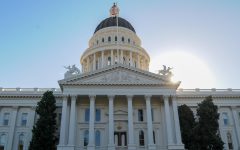
California State Capitol. (Photo: Kevin Sanders for California Globe)
Defined Words and Phrases in California’s Evidence Code
Defines an ‘action’ to include criminal and civil actions
By Chris Micheli, July 30, 2024 2:30 am
The California Evidence Code, in Division 2, contains numerous words and phrases and their definitions. Division 2 was first enacted in 1965 by Chapter 299. Section 100 states that the definitions contained in Division 2 govern the construction of the Evidence Code.
Section 105 defines an “action” to include criminal and civil actions. Section 110 defines “burden of producing evidence” as requiring a party to introduce evidence sufficient for favorable ruling.
Section 115 defines “burden of proof” as the requirement on a party to establish by evidence a requisite degree of belief concerning a fact in the mind of the trier of fact or the court. In addition, the burden of proof generally requires proof by a preponderance of the evidence.
Section 120 defines “civil action” to include civil proceedings. Section 125 defines “conduct” to include all types of behavior. Section 130 defines “criminal action” to include criminal proceedings. Section 135 defines “declarant” to be the person making a statement.
Section 140 defines “evidence” to include testimony, writings, material objects, or other things presented to the senses that are offered to prove the existence or nonexistence of a fact. Section 145 defines “the hearing” to mean the hearing at which a question arises.
Section 150 defines “hearsay evidence” as that contain in Section 1200 of the Evidence Code. Section 160 defines “law” to include constitutional, statutory, and decisional law. Section 165 defines “oath” to include an affirmation or declaration under penalty of perjury.
Section 170 defines “perceive” to mean acquiring knowledge through one’s senses. Section 175 defines “person” as a natural person, firm, association, organization, partnership, business trust, corporation, limited liability company, or public entity.
Section 177 defines “dependent person” to generally mean a person who has a physical or mental impairment that substantially restricts his or her ability to carry out normal activities or to protect his or her rights. Section 180 defines “personal property to include money, goods, chattels, things in action, and evidences of debt. Section 185 defines “property” to include real and personal property.
Section 190 defines “proof” as establishing by evidence of a requisite degree of belief concerning a fact in the mind of the trier of fact or the court. Section 195 defines “public employee” as an officer, agent, or employee of a public entity. Section 200 defines “public entity” to include all forms of public agencies whether foreign or domestic.
Section 205 defines “real property” as lands, tenements, and hereditaments. Section 210 defines “relevant evidence” as having any tendency in reason to prove or disprove any disputed fact that is of consequence to the determination of the action. Section 215 defines “spouse” to include a registered domestic partner.
Section 220 defines “state” to mean California. Section 225 defines “statement” as an oral or written verbal expression or nonverbal conduct of a person intended by him as a substitute for oral or written verbal expression. Section 230 defines “statute” to include a treaty and a constitutional provision.
Section 235 defines “trier of fact” to include the jury and the court. Section 240 defines “unavailable as a witness” to mean that the person is exempted or precluded from testifying or disqualified from testifying, as well as being unable to do so because of physical or mental infirmity, absence, or persistent refusal.
Section 250 defines “writing” to include all forms of communication. Section 255 defines “original” to mean the writing itself or a photo negative. Section 260 defines “duplicate to mean a counterpart produced by the same impression.
- Statewide Child Support Registry - January 2, 2026
- Foreign Country Money Judgments - January 2, 2026
- How Many Bills Are on the Inactive Files? - January 1, 2026




